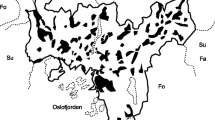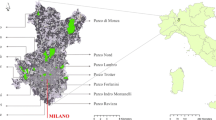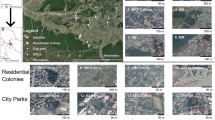Abstract
Characteristics of urban natural areas and surrounding landscapes were identified that best explain winter bird use for 28 urban natural areas in southern Ontario, Canada. The research confirms for winter birds the importance of area (size) and natural vegetation, rather than managed, horticultural parkland, within urban natural areas as well as percent urban land use and natural habitat in surrounding landscapes. Alien bird density and percent ground feeding species increased with percent surrounding urban land use. Higher percent forest cover was associated with higher percentages of forest, bark feeding, small (<20 g) and insectivorous species. Natural area size (ha) was related to higher species richness, lower evenness and higher percentages of insectivorous, forest interior, area-sensitive, upper canopy, bark feeding, and non-resident species. Higher number of habitat types within natural areas and percent natural habitat in surrounding landscapes were also associated with higher species richness. Common, resident bird species dominated small areas (<6.5 ha), while less common non-residents increased with area, indicative of a nested distribution. Areas at least 6.5 ha and more generally >20 ha start to support some area-sensitive species. Areas similar to rural forests had >25% insectivores, >25% forest interior species, >25% small species, and <5% alien species. Indicator species separated urban natural areas from rural habitats and ordination placed urban natural areas along a gradient between urban development and undisturbed, rural forests. More attention is needed on issues of winter bird conservation in urban landscapes.


Similar content being viewed by others
References
Adams L. 1994. Urban wildlife habitats: a landscape perspective. University of Minneapolis Press, Minneapolis, 186 pp
Adams L., L. Dove. 1989. Wildlife reserves and corridors in the urban environment: a guide to ecological landscape planning and resource conservation. National Institute for Urban Wildlife, Sheperdstown, West Virginia, 91 pp
Austen M., C. Francis, D. Burke, M. Bradstreet. 2001. Landscape context and fragmentation effects on forest birds in Southern Ontario. Condor 103:701–714
Belbin L. 1995. A multivariate approach to the selection of biological reserves. Biodivers Conserv 4:951–963
Bellamy P., S. Hinsley, I. Newton. 1996a. Local extinctions and recolonisations of passerine bird populations in small woods. Oecologia 108:64–71
Bellamy P., S. Hinsley, I. Newton. 1996b. Factors influencing bird species numbers in small woods in south-east England. J Appl Ecol 33:249–262
Bird D., D. Varland, J. Negro. 1996. Raptors in Human Landscapes: Adaptations to built and cultivated environments. Academic Press, London, 396 pp
Blake J. 1987. Species-area relationships of winter residents in isolated woodlots. Wilson Bull 99:243–250
Bock, C., T. Root. 1981. The Christmas Bird Count and avian ecology. In C. Ralph and J. Scott (eds), Estimating the numbers of terrestrial birds. Studies in Avian Biology 6, pp 17–23
Boonstra R. 2004. Coping with changing northern environments: the role of the stress axis in birds and mammals. Integr Comp Biol 44:95–108
Bryce S., R. Hughes, P. Kaufmann. 2002. Development of a bird integrity index: using bird assemblages as indicators of riparian condition. Environ Manage 30:294–310
Burke D., E. Nol. 2000. Landscape and fragment size effects on reproductive success of forest-breeding birds in Ontario. Ecol Appl 10:1749–1761
Burnham K., D. Anderson. 2002. Model selection and multi-model inference: a practical information-theoretic approach. 2nd ed. Springer-Verlag, New York, 488 pp
Cabeza, M., A. Moilanen. 2001. Design of reserve networks and the persistence of biodiversity. Trends Ecol Evol 16:242–248
Cadman, M., P. Eagles, F. Helleiner. 1987. Atlas of the breeding birds of Ontario. University of Waterloo Press, Waterloo, Canada, 617 pp
Campbell C., A. Dagg. 1976. Bird populations in downtown and suburban Kitchener-Waterloo, Ontario. Ontario Field Biol 30:1–22
Chace J., J. Walsh. 2006. Urban effects on native avifauna: a review. Landscape Urban Plan 74:46–69
Clergeau P., J. Jokimäki, J.-P. Savard. 2001. Are urban bird communities influenced by the bird diversity of adjacent landscapes? J Appl Ecol 38:1122–1134
Clergeau P., S. Croci, J. Jokimäki, M.-L. Kaisanlahti-Jokimäki, M. Dinetti. 2006. Avifauna homogenisation by urbanization: analysis at different European latitudes. Biol Conserv 127:336–344
Crosby N., R. Blair. 2001. Do temporal trends in Christmas Bird Counts reflect the spatial trends of urbanization in southwest Ohio? In J. Marzluff, R. Bowman, R. Donnelly (eds), Avian ecology and conservation in an urbanizing world. Kluwer Academic, Norwell, MA, pp 19–47
Degraaf R., N. Tilghman, S. Anderson. 1985. Foraging guilds of North American birds. Environ Manage 9:493–536
Doherty P., T. Grubb. 2000. Habitat and landscape correlates of presence, density, and species richness of birds wintering in forest fragments in Ohio. Wilson Bull 112:388–394
Doherty P., T. Grubb. 2002. Survivorship of permanent-resident birds in a fragmented forested landscape. Ecology 83:844–857
Donnelly R., J. Marzluff. 2004. Importance of reserve size and landscape context to urban bird conservation. Conserv Biol 18:733–745
Dunning J. 1993. The CRC handbook of bird weights. CRC Press, Boca Raton, Florida, 371 pp
Environment Canada. 2004. How much habitat is enough? A framework for guiding habitat rehabilitation in Great Lakes Areas of Concern. Environment Canada, Downsview, Ontario, Canada, 80 pp
Environment Canada. 2006. How much habitat is enough? Area-sensitive forest birds in urban areas. Environment Canada, Downsview, Ontario, Canada, 67 pp
Environmental Law Institute. 2003. Conservation thresholds for land use planners. The Environmental Law Institute, Washington, DC, 55 pp
Erskine A. 1980. Urban birds in the context of Canadian climate and settlement. In R. Murton, M. Luniak (eds), Symposium on Urbanization, Proceedings of the 17th International Ornithological Congress. Berlin, Germany, pp 1321–1326
Fahrig L. 2003. Effects of habitat fragmentation on biodiversity. Annu Rev Ecol Evol System 34:487–515
Fairbanks D., B. Reyers, A. Van Jaarsveld. 2001. Species and environment representation: selecting reserves for the retention of avian diversity in KwaZulu-Natal, South Africa. Biol Conserv 98:365–379
Fernández-Juricic E. 2002. Nested patterns of species distribution and winter flock occurrence of insectivorous birds in a fragmented landscape. Ecoscience 9:450–458
Fernández-Juricic E., J. Jokimäki. 2001. A habitat island approach to conserving birds in urban landscapes: case studies from southern and northern Europe. Biodivers Conserv 10:2023–2043
Figley W. K., L. W. VanDruff. 1982. The ecology of urban Mallards. Wildlife Monogr 81:1–40
Fischer J., D. Lindenmayer. 2005. Perfectly nested or significantly nested an important difference for conservation management. Oikos 109:485–494
Friesen L., P. Eagles, R. Mackay. 1995. Effects of residential development on forest-dwelling neotropical migrant songbirds. Conserv Biol 9:1408–1414
Gauch H., R. Whittaker. 1981. Hierarchical classification of community data. J Ecol 69:537–557
Gilbert O. 1989. The ecology of urban habitats. Chapman and Hall, London, 369 pp
Hawkins B., R. Field, H. Cornell, D. Currie, J-F. Guégan, D. Kaufman, J. Kerr, G. Mittelbach, T. Oberdorff, E. O’Brien, E. Porter, J. Turner. 2003. Energy, water, and broad-scale geographic patterns of species richness. Ecology 84:3105–3117
Herbers J., R. Serrouya, K. Maxcy. 2004. Effects of elevation and forest cover on winter birds in mature forest ecosystems of southern British Columbia. Can J Zool 82:1720–1730
Hennings L., D. Edge. 2003. Riparian bird community structure in Portland, Oregon: habitat, urbanization, and spatial scale patterns. Condor 105:288–302
Heusmann H., R. Burrell. 1984. Park waterfowl populations in Massachusetts. J Field Ornithol 55:89–96
Hinsley S., P. Bellamy, I. Newton, T. Sparks. 1996. Influences of population size and woodland area on bird species distributions in small woods. Oecologia 105:100–107
Hill M. 1973. Diversity and evenness: a unifying notation and its consequences. Ecology 54:427–432
Hill M., H. Gauch. 1980. Detrended correspondence analysis: an improved ordination technique. Vegetation 42:47–58
Hill M., R. Bunce, M. Shaw. 1975. Indicator species analysis, a divisive polythetic method of classification, and its application to a survey of native pinewoods in Scotland. J Ecol 63:597–613
Holloway G., B. Naylor, W. Watt (eds). 2004. Habitat relationships of wildlife in Ontario. Revised habitat suitability models for the Great Lakes-St. Lawrence and Boreal East forests. Ontario Ministry of Natural Resources, Southern Science and Information Section and Northeast Science and Information. Joint Technical Report No. 1. Peterborough, Ontario
Huertas D., J. Diaz. 2001. Winter habitat selection by a montane forest bird assemblage: the effects of solar radiation. Can J Zool 79:279–284
Ichinose T., K. Katoh. 1998. Factors influencing bird distribution among isolated woodlots on a heterogeneous landscape in Saitama Pref., Japan. Ekologia (Bratislava) 17:298–310
Johnson J., K. Omland. 2004. Model selection in ecology and evolution. Trends Ecol Evol 19:101–108.
Jokimäki J. 1999. Occurrence of breeding bird species in urban parks: Effects of park structure and broad-scale variables. Urban Ecosyst 3:21–34
Jokimaki J., M. Kaisanlahti-Jokimaki. 2003. Spatial similarity of urban bird communities: a multiscale approach. J Biogeogr 30:1183–1193
Jokimäki J., J. Suhonen. 1998. Distribution and habitat selection of wintering birds in urban environments. Landscape Urban Plan 39:253–263
Jokimäki J., J. Suhonen, K. Inki, S. Jokinen. 1996. Biogeographical comparison of winter bird assemblages in urban environments in Finland. J Biogeogr 23:379–386
Jokimäki J., P. Clergeau, M. Kaisanlahti-Jokimäki. 2002. Winter bird communities in urban habitats: a comparative study between central and northern Europe. J Biogeogr 29:69–79
Kadane J., N. Lazar. 2004. Methods and criteria for model selection. J Am Stat Assoc 99:279–290
Karr J. 1993. Measuring biological integrity: lessons from streams. In S. Woodley, J. Kay, G. Francis (eds), Ecological integrity and the management of ecosystems. St. Lucie Press, Ottawa, pp 83–103
Kolb H. 1965. The Audubon winter bird population study. Audubon Field Notes 19:432–434
Lancaster R., W. Rees. 1979. Bird communities and the structure of urban habitats. Can J Zool 57:2358–2368
Mancke R., T. Gavin. 2000. Breeding bird density in woodlots: effects of depth and buildings at the edges. Ecol Appl 10:598–611
Margules C., R. Pressey. 2000. Systematic conservation planning. Nature 405:243–253
Magurran A. 2004. Measuring biological diversity. Blackwell Publishing, Oxford, UK, 256 pp
Marzluff J. 2001a. Worldwide increase in urbanization and its effects on birds. In J. Marzluff, R. Bowman, R. Donnelly (eds), Avian ecology and conservation in an urbanizing world. Kluwer Academic, Norwell, MA, pp 19–47
Marzluff J. 2001b. History of urban bird research. In J. Marzluff, R. Bowman, R. Donnelly (eds), Avian ecology and conservation in an urbanizing world. Kluwer Academic, Norwell, MA, pp 1–17
Marzluff J., F. Gehlbach, D. Manuwal. 1998. Urban environments: influences and challenges for the avian conservationist. In J. Marzluff R. Sallabanks (eds), Avian Conservation: Research and Management. Island Press, Washington, DC, pp 283–299
McIntyre N. 1995. Effects of forest patch size on avian diversity. Landscape Ecol 10:85–99
McLachlan G. 2004. Nonparametric discrimination. Discriminant analysis and statistical pattern recognition. Wiley, New York. 526 pp
McLaren M. 1998. Selection of Wildlife Species as Indicators of Forest Sustainability in Ontario. Summary of a Workshop held at Peterborough, Ontario on March 18–19, 1997 and Subsequent Recommendations. Ontario Ministry of Natural Resources, Peterborough, Ontario.
Meehan T., W. Jetz, J. Brown. 2004. Energetic determinants of abundance in winter landbird communities. Ecol Lett 7:532–537
Miller A. 2002. Subset selection in regression, 2nd ed. Monographs on Statistics and Applied Probability, Volume 95. CRC Press, Boca Raton, FL, 238 pp
Moilanen A., M. Nieminen. 2002. Simple connectivity measures in spatial ecology. Ecology 83:1131–1145
Mörtberg U. 2001. Resident bird species in urban forest remnants; landscape and habitat perspectives. Landscape Ecol 16:193–203
Nour N., R. Van Damme, E. Matthysen, A. A. Dhondt. 1999. Forest birds in forest fragments: are fragmentation effects independent of season? Bird Study 46:279–288
Oksanen J., P. Minchin. 1997. Instability of ordination results under changes in input data order: explanations and remedies. J Vegetat Sci 8:447–454
Ontario Ministry of Municipal Affairs and Housing. 2005. Greenbelt Plan, Toronto, 47 pp
Ontario Ministry of Public Infrastructure Renewal. 2006. Growth Plan for the Greater Golden Horseshoe, Toronto, 40 pp
Ontario Nature. 2004. Suggested Guidelines for the Identification of Significant Woodlands in Southern Ontario. Conserving Southern Woodlands Project, Toronto
Ontario Partners in Flight. 2005. Ontario Landbird Conservation Plan: Lower Great Lakes/St. Lawrence Plain (North American Bird Conservation Region 13), Priorities, Objectives and Recommended Actions. Environment Canada and Ministry of Natural Resources
Patterson B., W. Atmar. 2000. Analyzing species composition in fragments. In G. Rheinwald (ed), Isolated vertebrate communities in the tropics, Proc. 4th Int. Symp., Bonn. Bonn Zool Monogr 46, pp 9–24
Pim L., J. Ornoy 2002. A smart future for Ontario. How to protect nature and curb urban sprawl in your community. Federation of Ontario Naturalists, Toronto, 72 pp
Platt A., A. Lill. 2006. Composition and conservation value of bird assemblages of urban habitat islands: Do pedestrian traffic and landscape variables exert an influence? Urban Ecosyst 9:83–97
Polo V., L. Carrascal. 1999. Shaping the body size distribution of passeriformes: habitat use and body size are evolutionarily and ecologically related. J Anim Ecol 68:324–337
Possingham H., I. Ball, S. Andelman. 2000. Mathematical methods for identifying representative reserve networks. In S. Ferson, M. Burgman (eds), Quantitative methods for conservation biology. Springer-Verlag, New York, pp 291–305
Ranney J., M. Bruner, J. Levenson. 1981. The importance of edge in the structure and dynamics of forest islands. In R. Burgess, D. Sharpe (eds), Forest Island dynamics in man-dominated landscapes. Springer Verlag, New York, pp 67–95
Robbins C. 1972. An appraisal of the winter bird population study technique. Am Birds 26:688–692
Robbins C. 1981. Reappraisal of the winter bird population study technique. In C.J. Ralph, J.M. Scott (eds), Estimating the numbers of terrestrial birds. Studies in Avian Biology 6, pp 52–57
Robbins C., D. Dawson, B. Dowell. 1989. Habitat area requirements of breeding forest birds of the middle Atlantic states. Wildlife Monographs No. 103, 34 pp
Roberts J., G. Schnell. 2006. Comparison of survey methods for wintering grassland birds. J Field Ornithol 77:46–60
Root T. 1988. Atlas of wintering birds of North America: an analysis of Christmas bird count data. University of Chicago Press, Chicago
Saetersdal M., H. Birks. 1993. Assessing the representativeness of nature reserves using multivariate analysis: vascular plants and breeding birds in deciduous forests, western Norway. Biol Conserv 65:121–132
Schlaepfer M., M. Runge, P. Sherman. 2002. Ecological and evolutionary traps. Trends Ecol Evol 17:474–480
Smith P. 2003. Winter bird use of urban and rural habitats in Ontario. Can Field Nat 117:173–183
Smith P. 1984a. Observer and annual variation in winter bird population studies. Wilson Bull 96:561–574
Smith P. 1984b. Winter birds of small urban woodlots in Kitchener-Waterloo. Am Birds 38:60–61
Smith P., J. Theberge. 1986. A review of criteria used to evaluate natural areas. Environ Manage 10:715–734
Smith P., J. Theberge. 1987. Evaluating natural areas using multiple criteria: Theory and practice. Environ Manage 11:447–460
Smith P., V. Glooschenko, D. Hagan. 1991. Coastal wetlands of three Canadian Great Lakes: inventory, current conservation initiatives and patterns of variation. Can J Fish Aquat Sci 48:1581–1594
Smith P., G. Fairfield, D. Burton, D. Knauber. 1982. Winter bird communities of urban southern Ontario. Am Birds 36:46–47
Smith P., D. Knauber, D. Ulster, D. Banville, J. MacDonald, G. Fairfield, D. Burton. 1981. Winter bird communities of selected areas in Toronto. Am Birds 35:41–44
Taggart J. 1994. Ordination as an aid in determining priorities for plant community protection. Biol Conserv 68:135–141
Telleria J., T. Santos. 1995. Effects of forest fragmentation on a guild of wintering passerines: the role of habitat selection. Biol Conserv 71:61–67
Telleria J., T. Santos. 1997. Seasonal and interannual occupation of a forest archipelago by insectivorous passerines. Oikos 78:239–244
Tilghman N. 1987. Characteristics of urban woodlands affecting winter bird diversity and abundance. Forest Ecol Manage 21:163–175.
Thompson B., M. Hughes, M. Anderson. 2001. Effects of including non-breeding bird species on predicted bird distributions for conservation planning in New Mexico. Biol Conserv 100:229–242
Trzcinski M., L. Fahrig, G. Merriam. 1999. Independent effects of forest cover and fragmentation on the distribution of forest breeding birds. Ecol Appl 9:586–593
Whitcomb R., C. Robbins, J. Lynch, B. Whitcomb, M. Klimkiewicz, D. Bystrak. 1981. Effects of forest fragmentation on avifauna of the eastern deciduous forest. In R. Burgess, D. Sharpe (eds), Forest island dynamics in man-dominated landscapes. Springer Verlag, New York, pp 125–205
Williams J., C. ReVelle, S. Levin. 2005. Spatial attributes and reserve design models: A review. Environ Model Assess 10:163–181
Williams P., D. Gibbons, C. Margules, A. Rebelo, C. Humphries, R. Pressey. 1996. A comparison of richness hotspots, rarity hotspots and complementary areas for conserving diversity of British birds. Conserv Biol 10:155–174
Woodley S., J. Kay, G. Francis. 1993. Ecological integrity and the management of ecosystems. St. Lucie Press, Ottawa, 220 pp
Zajc E. 2005. Modelling native bird diversity in the Greater Toronto Area. Master’s of Environmental Studies thesis, University of Waterloo, Waterloo, Ontario, Canada
Acknowledgments
J. Jokimäki, J. Theberge, M. Cadman, G. Francis, and three anonymous reviewers provided comments on drafts of the manuscript. Thanks are extended to the many people who conducted the winter bird population studies used in this paper. The Toronto Field Naturalists, Toronto Bird Observatory, and James L. Baillie Fund supported a number of these field studies.
Author information
Authors and Affiliations
Corresponding author
Rights and permissions
About this article
Cite this article
Smith, P.G.R. Characteristics of Urban Natural Areas Influencing Winter Bird Use in Southern Ontario, Canada. Environmental Management 39, 338–352 (2007). https://doi.org/10.1007/s00267-005-0028-2
Received:
Accepted:
Published:
Issue Date:
DOI: https://doi.org/10.1007/s00267-005-0028-2




